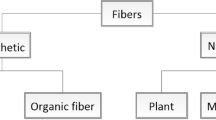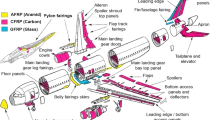Abstract
Carbon fiber-reinforced polymer (CFRP) composites are used in aerospace applications because of their superior mechanical properties and light weight. Avoiding damage in the machining of CFRP composites is difficult using traditional methods. Abrasive water jet (AWJ) has recently become one of the preferred machining methods for CFRP composites. This study evaluated the AWJ machinability of CFRP composites having three different fiber orientation angles (M1: [0°/90°]s, M2: [+ 45°/− 45°]s, and M3: [0°/45°/90°/− 45°]s) according to the delamination factor (Df), and the average surface roughness (Ra) as quality characteristics of the drilled holes. The aim of the study was to investigate the effects of different levels of AWJ drilling parameters on the delamination factor and surface roughness and to determine the optimum drilling parameter levels that provide minimum delamination formation and surface roughness values. For this purpose, AWJ drilling experiments were carried out using the Taguchi L16 (44) orthogonal array. Water pressure (WP), stand-off distance (L), traverse feed rate (F), and hole diameter (D) were chosen as process parameters. Analysis of variance was used to determine the percentage effects of the AWJ drilling process parameters. The microscopic surface roughness and delamination formation properties of the machined surfaces were revealed using a scanning electron microscope and an optical microscope, respectively. The most effective parameters on Df and Ra in the AWJ drilling of M1, M2 and M3 CFRP materials were determined to be water pressure, and stand-off distance. Minimum Df and Ra values were obtained when AWJ drilling the M3 CFRP composite with a fiber orientation angle of [0°/45°/90°/− 45°]s. Minimum delamination formation and very good surface quality can be obtained when the optimum process parameters determined in this study are used in the planning process for the AWJ drilling of CFRP composites having different fiber orientation angles.












Similar content being viewed by others
References
Chung DD (2010) Composite materials: science and applications. Springer, Berlin
Leone C, Genna S, Tagliaferri V (2014) Fibre laser cutting of CFRP thin sheets by multi-passes scan technique. Opt Lasers Eng 53:43–50
Arul S et al (2006) The effect of vibratory drilling on hole quality in polymeric composites. Int J Mach Tools Manuf 46(3–4):252–259
Gaitonde V et al (2008) Analysis of parametric influence on delamination in high-speed drilling of carbon fiber reinforced plastic composites. J Mater Process Technol 203(1):431–438
Guu YH et al (2001) Effect of electrical discharge machining on the characteristics of carbon fiber reinforced carbon composites. J Mater Sci 36(8):2037–2043
Arisawa H, Akama S, Niitani H (2012) High-performance cutting and grinding technology for CFRP (carbon iber reinforced plastic). Mitsu Heavy Ind Tech Rev 49(3):3–9
Shukla M, Davim J Paulo (2013) Nontraditional machining processes, vol 39. Springer, Berlin
Davim JP, Reis P, Antonio CC (2004) Experimental study of drilling glass fiber reinforced plastics (GFRP) manufactured by hand lay-up. Compos Sci Technol 64(2):289–297
Drakonakis VM et al (2010) Matrix hybridization in the interlayer for carbon fiber reinforced composites. Polym Compos 31(11):1965–1976
Tsao C, Hocheng H (2007) Effect of tool wear on delamination in drilling composite materials. Int J Mech Sci 49(8):983–988
König W et al (1985) Machining of fibre reinforced plastics. CIRP Ann Manuf Technol 34(2):537–548
Kılıçkap E (2010) CETP Kompozitlerin Delinmesinde Oluşan Deformasyona Delme Parametrelerinin Etkisinin İncelenmesi. 2. Ulusal Tasarım İmalat ve Analiz Kongresi, p 77
Davim JP, Reis P (2003) Drilling carbon fiber reinforced plastics manufactured by autoclave-experimental and statistical study. Mater Des 24:315–324
Hashish M (2013) Trimming of CFRP aircraft components. In: 2013 WJTA-IMCA conference and expo, Houston, Texas
Alberdi A et al (2016) An experimental study on abrasive waterjet cutting of CFRP/Ti6Al4V stacks for drilling operations. Int J Adv Manuf Technol 86:691–704
Khashaba U (2004) Delamination in drilling GFR-thermoset composites. Compos Struct 63(3):313–327
Aich U et al (2014) Abrasive water jet cutting of borosilicate glass. Procedia Mater Sci 6:775–785
Unde PD et al (2015) Experimental investigations into abrasive waterjet machining of carbon iber reinforced plastic. J Compos 2015:1–9
Benedict GF (1987) Nontraditional manufacturing processes, vol 19. CRC Press, Boca Raton
Chung Y (1992) Development of prediction technique for the geometry of the abrasive waterjet generated kerf Dissertations 1154
Dittrich M et al (2014) Process analysis of water abrasive fine jet structuring of ceramic surfaces via design of experiment. Procedia Cirp 14:442–447
Hashish M (2014) Waterjet trimming and drilling of CFRP components for advanced aircraft. SME, 2014 technical paper
Shanmugam DK, Nguyen T, Wang J (2008) A study of delamination on graphite/epoxy composites in abrasive waterjet machining. Compos A Appl Sci Manuf 39(6):923–929
Phapale K et al (2016) Delamination characterization and comparative assessment of delamination control techniques in abrasive water jet drilling of CFRP. Procedia Manuf 5:521–535
Miron AV et al (2013) Studies on water jet cutting of 2D parts made from carbon iber composite materials. Acad J Manuf Eng 11(2):87–92
Wang J, Guo D (2002) A predictive depth of penetration model for abrasive waterjet cutting of polymer matrix composites. J Mater Process Technol 121(2):390–394
Mayuet PF et al (2015) SOM/SEM based characterization of internal delaminations of CFRP samples machined by AWJM. Procedia Eng 132:693–700
Miller J, Eneyew ED, Ramulu M (2013) Machining and drilling of carbon fiber reinforced plastic (CFRP) Composites. SAMPE J 49(2):36–47
Jagadeesh B et al (2018) Experimental investigation and optimization of abrasive water jet cutting parameters for the improvement of cut quality in carbon fiber reinforced plastic laminates. J Ind Text 48(1):178–200
Abidi A, Salem SB, Yallese MA (2019) Experimental and analysis in abrasive water jet cutting of carbon fiber reinforced plastics. In: 24ème Congrès Français de Mécanique. 2019: Brest, 26 au 30 Août
Dhanawade A, Kumar S (2019) Study on carbon epoxy composite surfaces machined by abrasive water jet machining. J Compos Mater 53(20):2909–2924
Dhanawade A, Kumar S (2017) Experimental study of delamination and kerf geometry of carbon epoxy composite machined by abrasive water jet. J Compos Mater 51(24):3373–3390
Dhanawade A, Kumar P, Kumar S (2020) Experimental study on abrasive water jet machining of carbon epoxy composite. Adv Mater Process Technol 6(1):40–53
Thongkaew K, Wang J, Li W (2019) An investigation of the hole machining processes on woven carbon-fiber reinforced polymers (CFRPs) using abrasive waterjets. Mach Sci Technol 23(1):19–38
Kumar D, Gururaja S (2020) Abrasive waterjet machining of Ti/CFRP/Ti laminate and multi-objective optimization of the process parameters using response surface methodology. J Compos Mater 54(13):1741–1759
Vigneshwaran S, Uthayakumar M, Arumugaprabu V (2018) Abrasive water jet machining of fiber-reinforced composite materials. J Reinf Plast Compos 37(4):230–237
Kale SA (2019) Comprehensive evaluation of abrasive water jet machining of fiber reinforced polymers. J Polym Compos 7(1):7–16
Kim G, Denos BR, Sterkenburg R (2020) Influence of different piercing methods of abrasive waterjet on delamination of fiber reinforced composite laminate. Compos Struct 240:112065
Ramesha K et al (2019) Effect of the process parameters on machining of GFRP composites for different conditions of abrasive water suspension jet machining. Arab J Sci Eng 44(9):7933–7943
Prasad KS, Chaitanya G (2019) Experimental study on surface roughness and dimensional accuracy of hole machining process on GFRP composites using abrasive water jet technique. Mater Today Proc 23(3):651–658
Deepak D, Davim JP (2019) Multi-response optimization of process parameters in AWJ machining of hybrid GFRP composite by grey relational method. Procedia Manuf 35:1211–1221
Deepak D, Pai A (2019) Study on abrasive water jet drilling for graphite filled glass/epoxy laminates. J Mech Eng Sci 13(2):5126–5136
Li M et al (2019) Experimental study on hole characteristics and surface integrity following abrasive waterjet drilling of Ti6Al4V/CFRP hybrid stacks. Int J Adv Manuf Technol 104(9–12):4779–4789
Kumar P, Kant R (2019) Experimental study of abrasive water jet machining of Kevlar epoxy composite. J Manuf Eng 14(1):026–032
Gupta K (2020) Abrasive water jet machining of ceramic composites. In: Jagadish, Gupta K (ed) Abrasive water jet machining of engineering materials. Springer, Cham, pp 51–71
Mohanraj A et al (2019) Parameter optimization of abrasive water jet machining in aluminium 6061 material. Int J Eng Sci 9(3):1–3
Sankar SS, Reddy MVK, Pandian RS (2019) Multi-objective optimization of process parameters in abrasive water jet machining by using VIKOR. i-Manager’s J Future Eng Technol 14(4):39–47
Azmir MA, Ahsan AK (2009) A study of abrasive water jet machining process on glass/epoxy composite laminate. J Mater Process Technol 209(20):6168–6173
Karatas M, Gokkaya H, Nalbant M (2019) Optimization of machining parameters for abrasive water jet drilling of carbon fiber-reinforced polymer composite material using Taguchi method. Aircr Eng Aerosp Technol 92(2):128–138
Meltem AK, Motorcu AR, Gökkaya A (2020) Optimization of machining parameters for Kerf angle and roundness error in abrasive water jet drilling Of CFRP composites with different fiber orientation angles. J Braz Soc Mech Sci Eng 42:173
Acknowledgements
This research was funded by Karabük University. The authors would like to thank the Karabük University Coordinatorship of Research Projects for their support (Award Number: KBÜ-BAP-16/2-DR-101).
Funding
The authors have received research grants from Karabük University.
Author information
Authors and Affiliations
Corresponding author
Additional information
Technical Editor: Lincoln Cardoso Brandao.
Publisher's Note
Springer Nature remains neutral with regard to jurisdictional claims in published maps and institutional affiliations.
Rights and permissions
About this article
Cite this article
Altin Karataş, M., Motorcu, A.R. & Gökkaya, H. Study on delamination factor and surface roughness in abrasive water jet drilling of carbon fiber-reinforced polymer composites with different fiber orientation angles. J Braz. Soc. Mech. Sci. Eng. 43, 22 (2021). https://doi.org/10.1007/s40430-020-02741-4
Received:
Accepted:
Published:
DOI: https://doi.org/10.1007/s40430-020-02741-4




